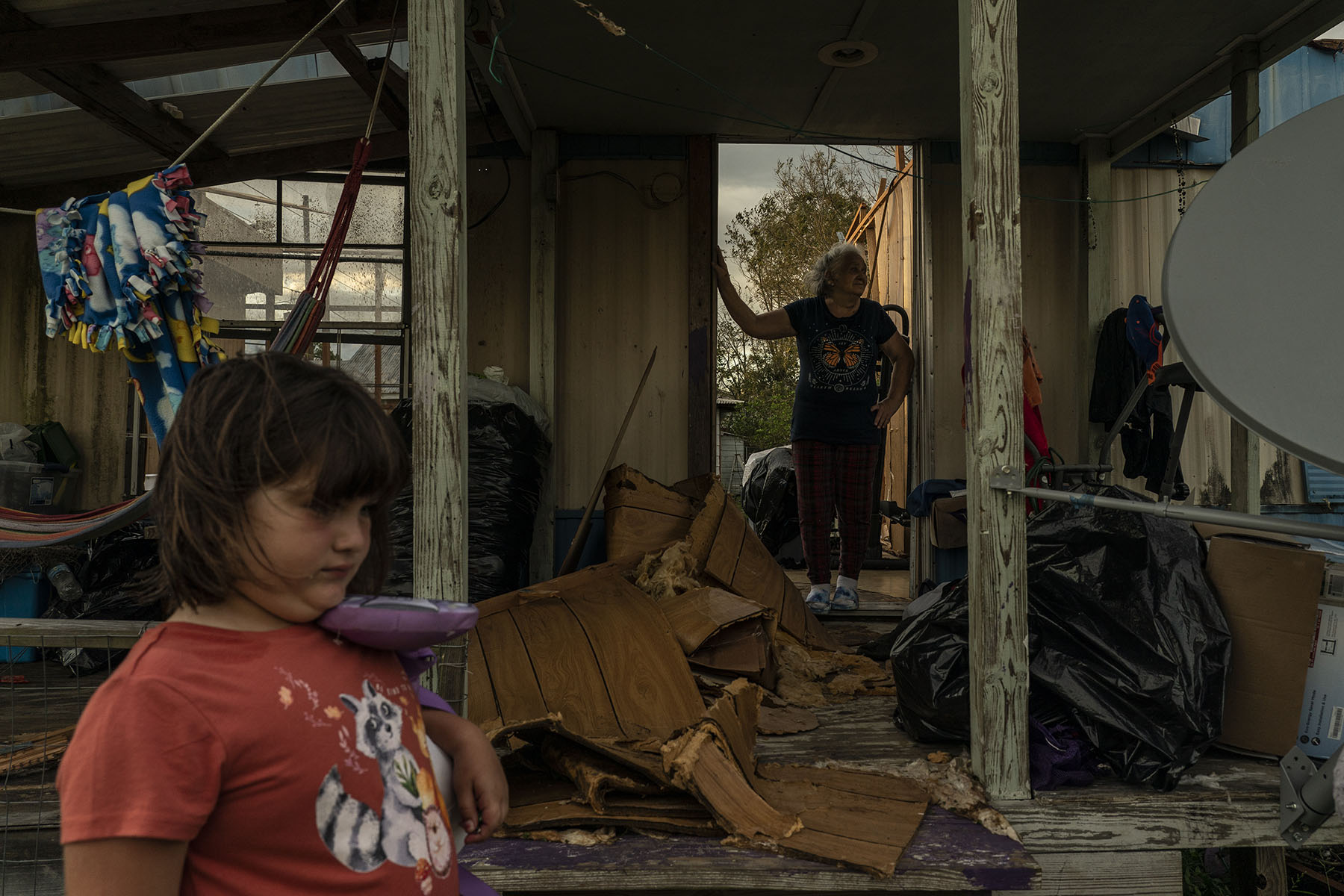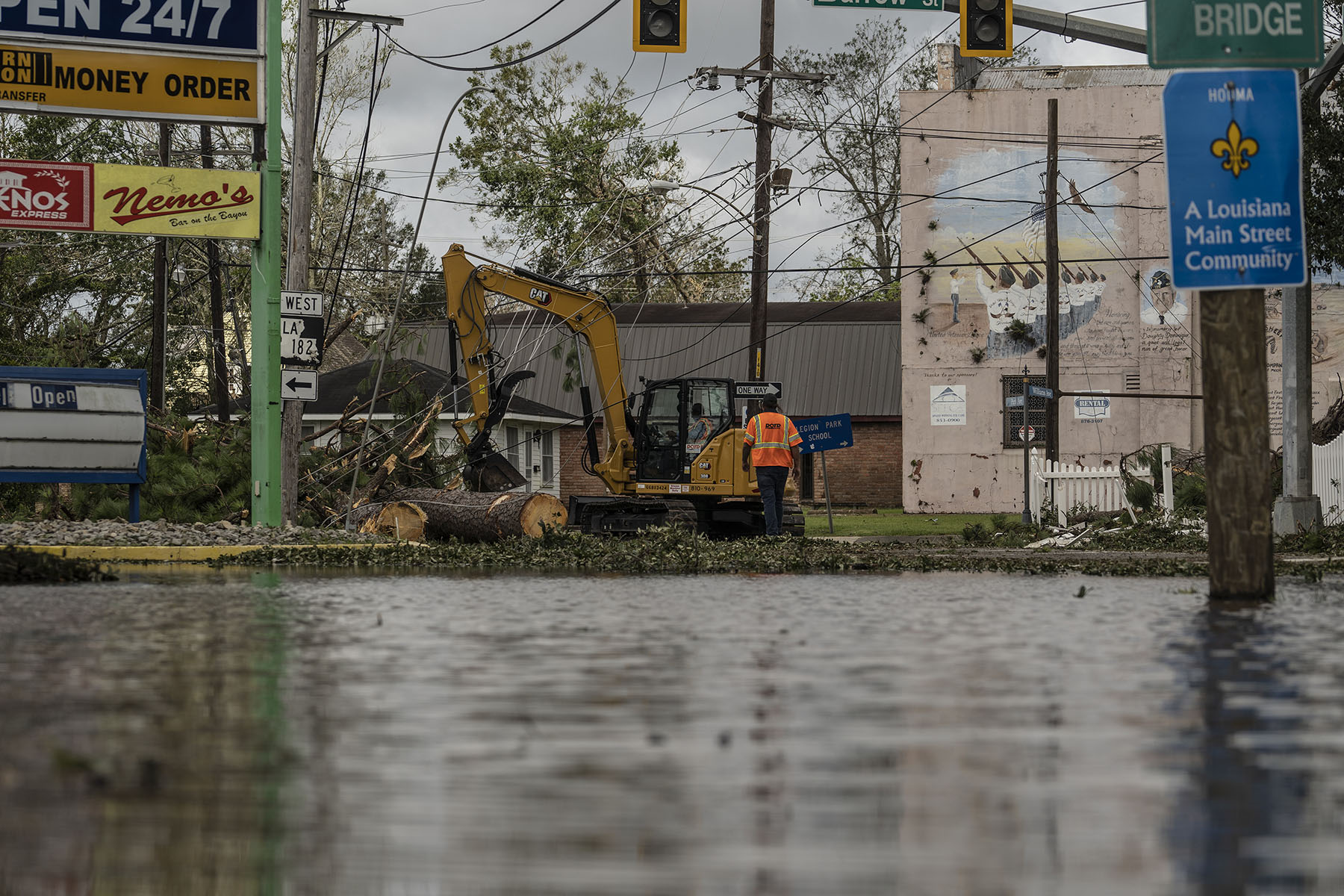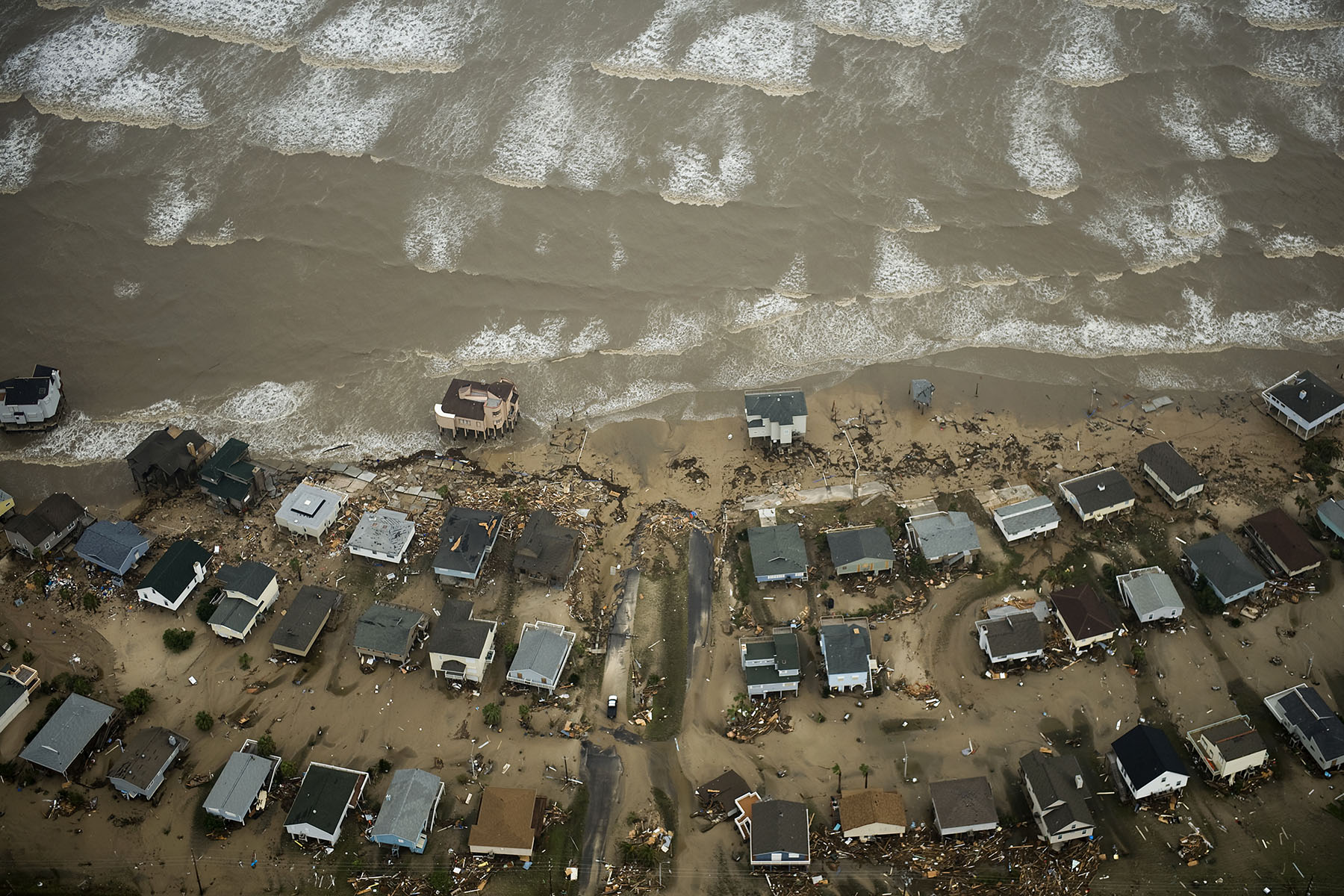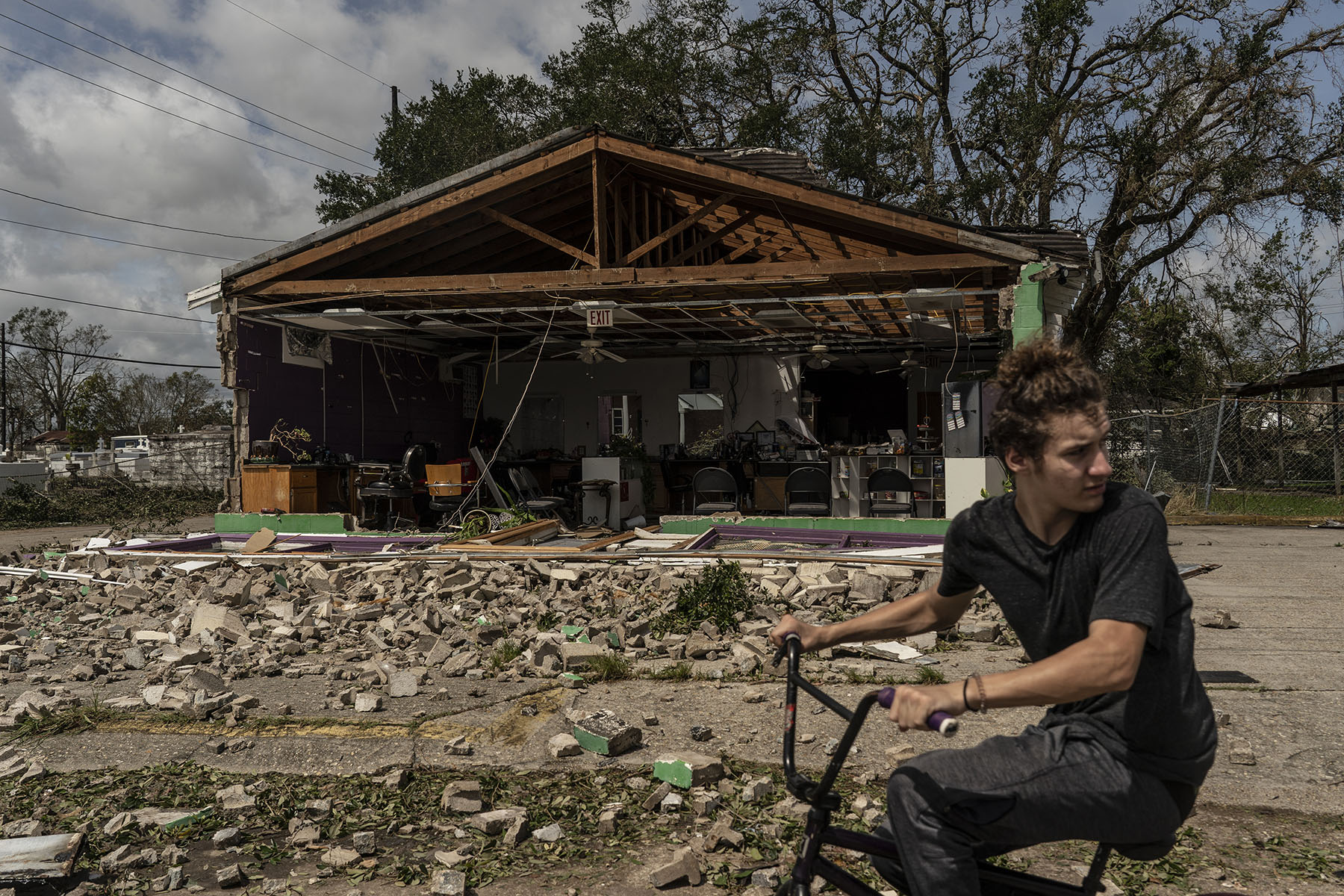Before Hurricane Ida made landfall as a Category 4 storm in August 2021, Precious Shephard and her son packed clothing and other essentials and left their home in the southeast Louisiana city of Houma to take shelter.
When they returned a few weeks later, they found the public housing complex they lived in, Senator Circle, partially destroyed by the hurricane. Trees had toppled over. Shingles were missing from the roofs of some houses. Others had severe water damage.
But the damage wasn’t uniform. Senator Circle comprises 217 units, most of which are single-story duplexes. Shephard’s unit, like many others on the property, had been mostly spared from extensive damage, so she decided to stay.
“I had nowhere to go. … If I leave and go somewhere else, I have to start all over and find another job. I didn’t have the proper transportation to get around to do that,” she said. “Not only that, prices for rent skyrocketed after the storm.”
Shephard, a single mom who works as a public school bus driver, and her teenage son went without electricity, depending for months on a generator that cost about $70 a week to keep fueled. She used an ice chest instead of her refrigerator to store her food to help keep use down. But for Shephard, it was better than the alternative. Her income-based rent at the public housing unit was $766. She saw three-bedroom units renting for $1,500.
In November 2021, the Houma-Terrebonne Housing Authority, which manages the complex, tried to terminate the leases of Shephard and a handful of other residents who had opted to stay in their units, citing “catastrophic damage” to the complex. But Shephard fought back, seeking the help of a pro bono lawyer. She and 10 other residents, mostly other single moms, filed a lawsuit in February 2022.
The lawsuit alleges that the public housing authority improperly cut their leases short and did not provide proper relocation assistance to help residents find comparable housing after the storm. The plaintiffs are seeking comparable housing or compensation.
Two years later, Shephard is one of four tenants allowed to remain in Senator Circle. Many other residents are stuck in a housing limbo, either living in trailers provided by the Federal Emergency Management Agency (FEMA) or the state; relocated to public housing outside of town; or using Section 8 housing choice vouchers, a program that subsidizes rent for housing they find on the private market.

The housing authority has assured residents that they have plans to rebuild Senator Circle, but hope is fading as the units sit empty. No timeline has been announced for demolition or construction.
Shephard’s ability to stay is dependent on the outcome of the lawsuit. She doesn’t know what she’ll do if she’s forced to leave — Senator Circle is where she grew up, where she raised her own family.
“That is what we are trying to explain to them,” she said. “It’s not just public housing. It’s home.”
Shephard’s story is one that is increasingly befalling public housing residents across the country as climate change intensifies disasters like hurricanes and flooding, chipping away at this affordable housing stock.
Like other low-income rental housing, public housing is at high risk to being damaged by natural disasters, both due to its condition and location. Across the country, aging public housing stock hasn’t seen significant renovations in decades, leaving much of it structurally frail. In the South, 16 percent of this housing stock is located in a 100-year or 500-year floodplain, according to New York University’s Furman Center. And due to rising sea levels, 5 percent of federally assisted housing is at risk of coastal flooding by 2050.
Public housing falls under the U.S. Department of Housing and Urban Development and serves some of the most economically vulnerable people in the country. For nearly 2 million low-income people, it is a stable and affordable place to live, with rent calculations based on income. In a country where the housing crisis is leading to an increase in homelessness, public housing is one of the few options that is a viable long-term housing solution for those who qualify.
Older people and people with disabilities disproportionately live in public housing, as do people of color: 42 percent of residents are Black and 26 percent are Latinx, according to the latest HUD data.
Public housing also disproportionately serves women. In the Houma-Terrebonne Housing Authority alone, 86 percent of households were women-led as of 2020. Nationwide, that number is a little lower at 75 percent, according to the latest HUD data.
As the climate crisis threatens to worsen the housing crisis in the country, it’ll be women of color disproportionately at risk of this type of climate displacement. After disasters, public housing often disappears forever. As the months tick by, Shephard is beginning to feel that’s what will happen at Senator Circle.
“I don’t think they are going to rebuild it,” she said. “I still don’t know where me and my family are going to wind up.”
In January, the Houma-Terrebonne Housing Authority held its first formal meeting since October 2021 to provide residents with an update about the two complexes the authority manages, Senator Circle and Bayou Towers.
The meeting was held at 2 p.m. on a Wednesday, a time when many former residents were working. Still, about a hundred people showed up, eager for any information about when renovations might start on their units. In the case of people who lived at Bayou Towers, which had 300 units and housed senior citizens, they wanted to know when they would have access to their belongings that had been trapped in the building since the storm.
Nikita Gilton, executive director of the housing authority, explained that everything was at standstill. Bayou Towers needed an environmental review before it could be demolished and rebuilt, and Senator Circle was caught up in a laborious insurance claim process. Ultimately, it would be years before both complexes are operational, she said. Gilton did not provide comment for this article, citing ongoing litigation.
“There are certain rules and regulations that I have to follow to make sure I’m doing the correct job,” she told the crowd gathered in a gymnasium. “I know it may seem the housing authority is not doing X-Y-Z, but I have a board I have to answer to, and I have to answer to HUD.”
It was nearly a year and a half after the storm, and residents had a lot of questions.
The Section 8 housing vouchers — which are typically used by women — offered to residents after the storm were difficult to use since many private landlords don’t accept them, and there is no law requiring that they do so. According to data supplied by the Terrebonne Parish Consolidated Government in court filings, in the six months after Hurricane Ida hit, only 37% of new voucher recipients successfully leased a unit before their vouchers expired. Between September 2022 and February of this year, that number rose to 53 percent.
Those who could use their vouchers suddenly found themselves incurring extra expenses like utility bills and deposits, which were covered when they lived in public housing. How were they supposed to pay for these added costs while dealing with other expenses accrued by the storm?
Or what about their belongings that had been left in Bayou Towers or removed by the housing authority in Senator Circle? How were they supposed to file insurance claims without being able to document damage? What were they supposed to do about all that they had lost? What were they supposed to do without a place to call home?
There were no HUD representatives available to speak with residents. And Gilton didn’t have many answers. Though she sympathized, Gilton assured residents she was doing everything she could to get housing rebuilt.
“When it is federal money, I can’t do some of the things that I’d like to do to assist you all,” she said, sounding exasperated.
The meeting illustrated the anguish most public housing residents find themselves in post-disaster, left to figure out what’s next on their own and with limited resources.

Public housing residents face many more barriers to long-term recovery than the general population due in part to their socioeconomic status, gender and race, said Andrew Aurand, senior vice president for research for the National Low Income Housing Coalition. He helped author a report that looks at the risks public housing and other federally assisted housing faces in disasters.
“Federally assisted housing … serves some of the most vulnerable and lowest-income families in the country. When their housing is damaged, or becomes inhabitable, they don’t have other options,” he said. “It’s an extremely important part of our affordable housing supply.”
But, in the aftermath of a disaster, public housing is rarely rebuilt. And if it is, it’s usually in the form of mixed-income developments, a model that HUD has embraced as it moves away from public housing, said Sara Hamideh, an associate professor at Stony Brook University. She has studied the recovery process of public housing after hurricanes Ike and Matthew, which hit in 2008 and 2016, respectively. What she found is that it can take several years before any public housing returns, and when it does it typically houses significantly less low-income tenants than the public housing buildings it replaces.
In comparison to homeowners and apartment complexes on the private market, it can also take much longer for public housing authorities to access funding to rebuild post disaster.
After Hurricane Ida, homeowners qualified for up to $200,000 to repair or replace their primary residence. Wealthier and Whiter neighborhoods typically receive more funds than low-income neighborhoods due to a host of factors, including lower property values, according to a report by the Center for American Progress, a public policy think tank.
A private landlord could also be motivated to renovate their properties to bring back renters. In Louisiana, $32 million became available to small landlords to bolster rental supply through HUD funding, under the Community Development Block Grant Disaster Recovery program.
But public housing residents are beholden to the management of a public housing authority and its ability to rebuild, which is often at the mercy of larger structural forces like federal policy and how the government distributes funding for public housing, Hamideh said.
“They are renters of the government,” Hamideh said. “Their landlord is HUD.”
In the case of Senator Circle, legal counsel for the housing authority in Houma stated in an email to The 19th that they are still waiting to have Senator Circle units assessed by FEMA to determine which units will need to be rebuilt. Any units requiring demolition will also have to receive approval from HUD to be rebuilt and be elevated to withstand flooding. There is no timeline for when any units will be back in the housing stock.
Hamideh says housing authorities should be thinking about adapting to the climate crisis before a disaster even hits.
“It doesn’t matter what you do to a building, when you’re so deep into a floodplain you have to relocate those complexes,” Hamideh said. “Relocating as a mitigation option should happen during normal times before the disaster.
The Houma-Terrebonne Housing Authority says it is committed to rebuilding its housing. But in other places Hamideh studied, like Galveston, Texas, she found that politicians used disasters as a way to advocate against public housing, delaying rebuilding.
After Hurricane Ike hit Galveston in 2008, Hamideh said, thousands of area residents signed a petition to prevent public housing from coming back. In his campaign for reelection, Lewis Rosen, the city’s mayor in the years after the hurricane, also voiced his opposition on his campaign website: “My position on rebuilding public housing is very simple: Don’t do it.”
A lack of political support delays the process of rebuilding, because local governments have some control over funding options for construction and ultimately have decision-making power. When public housing was eventually rebuilt, it was in the form of mixed-income housing, where only some of the units were affordable to public housing residents.
“They couldn’t fight it, but they could drag their feet long enough for all of those residents to be displaced and never come back,” Hamideh said.

Though the need for public housing has continued to grow due to a housing crisis, the concept itself became politically unpopular in the 1980s, when President Ronald Reagan strongly opposed public housing and cut funding to the program. In 1999, the Faircloth Amendment passed under the Clinton administration, essentially banning housing authorities from adding new units of housing to their inventory. So though they can rebuild units, they can’t increase the number of units. Instead HUD has expanded its Section 8 voucher program.
Much of the existing housing stock is aging: Senator Circle was built in the 1960s, and like most complexes in the United States has suffered from lack of investments. A strategic plan for the complex for 2020 to 2024 detailed issues with deteriorating water and sewer lines, as well as consistent flooding.
The Faircloth Amendment and cuts in federal spending for public housing, with funding for major repairs estimated to have dropped 35 percent in the last two decades, have decreased the public housing stock from 1.3 million units in 1996 to 958,000 units in 2019.
One of the biggest blows to public housing happened when Hurricane Katrina hit New Orleans in 2005 and around 5,000 public housing units disappeared. Some were destroyed by the hurricane, but other undamaged units were also demolished and replaced with mixed-income housing, a plan that had been in place since before the hurricane to “deconcentrate poverty,” according to NPR. Experts say that the disaster helped expedite what would have otherwise been a plan subject to years of bureaucratic wrangling and legal hoops.
In total, New Orleans now houses less than half as many families in public housing than it did before Hurricane Katrina, with around 1,900 families in several mixed-income complexes. It took a decade or longer for these developments to be built. “It really puts public housing residents in a big limbo,” Hamideh said. “Uncertainty is unimaginable for anybody who has to go through disaster recovery, but I can imagine it’s many times worse for a public housing resident.”
For many public housing residents in Houma, the yearslong wait and the uncertainty around their living situation took its toll.
Deja Allen, a public housing resident who moved into a FEMA trailer after Hurricane Ida, said the displacement made her depressed. She became pregnant the November after Ida hit and was in and out of the hospital due to stress.
Allen, who had a hard time finding child care for her three children, struggled with not knowing what would come next with no permanent place to go.
“I really feel like I’m in a standstill,” she said in January.
She tried to find a place to use a housing voucher, but whenever a unit came up that was in her price range, “it gets swept from under you in a blink of an eye.” It took 18 months for her to finally be able to use her voucher.
Some residents like Sanae Marshall had more luck using the temporary Section 8 voucher after being displaced. But the storm destroyed bigger dreams she had for her family. Marshall works at a local fast food restaurant making a minimum wage of $15 an hour while raising four sons. But she was able to save money while living at Senator Circle.
“Everything was fine there. I was in the process before the storm of trying to buy me a home,” she said. “I had maybe saved up $8,000 to $10,000 in my bank account, and I had signed up for a first-time home buyers assistance program.”
The storm drained her savings.
“We’ve been blessed, because we still have a roof over our heads and clothes on our backs and I do have a car, but it’s been really hard,” she said. “I think of my kids. … This was their home.”
Her eldest son is now working to help support the family instead of going to college like she had dreamed of. She, like other residents, feel like the housing authority abandoned them after the storm.
“These people did absolutely nothing,” she said. “I think they should have helped us out a lot more.”
At other public housing complexes Hamideh has studied, many residents end up outside of HUD housing completely after disasters, “going into worse housing situations that are much more temporary, that have major mental health and physical health implications and of course, financial implications,” she said.

Jane Henrici, an anthropologist who has spent decades studying gender and disasters, said the issue of public housing brings up bigger questions around why we don’t have adequate social protections in place for these communities to begin with.
“We do need to acknowledge from the start these disparities, the differentiation among people in terms of disaster vulnerabilities and impact,” she said. “There is a differentiation, I’m telling you, that is not yet in policy.”
That could mean planning beyond just housing after disasters, but planning for broader social needs like employment and transportation once someone is displaced, or relocation in areas where it doesn’t make sense to rebuild.
“How are you going to better prepare so that you don’t have long-term expenditures not just in terms of the individuals and their households, but in terms of the larger community?” she said.
Over two years after the storm, Shephard is still in a legal battle with the housing authority. Four women from the lawsuit have since settled with the housing authority, receiving a couple thousand dollars each. The other plaintiffs, including Shephard, are headed to trial in October.
For Shephard, the lawsuit is a matter of holding the housing authority accountable to its residents. Still, she says that there is another solution: “Provide us with comparable housing,” she said. “If not, pay us to leave so we can put that down on something.”
With the amount of money spent on temporary housing after disasters, she has a point. According to one study, FEMA trailers cost anywhere between $110,000 to $129,000 over the typical 18-month period in which they are deployed.
But though Shephard continues fighting, for many residents the option to return to Senator Circle just isn’t appealing anymore. Too much time has passed. Even if it’s rebuilt, they’ve already been forced to move on.
“I’m not interested in going back,” Marshall said. “I’m never going back. God bless me, I’m going further.”





